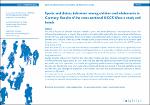Sports and dietary behaviour among children and adolescents in Germany. Results of the cross-sectional KiGGS Wave 2 study and trends
Krug, Susanne
Finger, Jonas D.
Lange, Cornelia
Richter, Almut
Mensink, Gert B. M.
This article focuses on selected indicators related to sports and dietary behaviour – two important factors that
influence the development of obesity. The analyses are based on data collected for the second wave of the German
Health Interview and Examination Survey for Children and Adolescents (KiGGS Wave 2), which was conducted
between 2014 and 2017. These data were collected, using a questionnaire, from 6,810 girls and 6,758 boys aged
between 3 and 17. The analyses also compare the data collected for wave 2 with those from the KiGGS baseline
study (2003-2006).
More than 70% of 3- to 17-year-olds state that they participated in sports. However, boys do so significantly more
often than girls, and 11- to 17-year-olds do so more frequently than 3- to 10-year-olds. In addition, there is a correlation
between children’s and adolescents’ sports participation and those of their parents, and with an activity-friendly
living environment.
Younger children and girls have healthier diets than older children and boys. However, although the consumption
of confectionery and sugary drinks by 3- to 17-year-olds has declined significantly since the KiGGS baseline study
was conducted, 11- to 17-year-olds, in particular, eat significantly smaller amounts of vegetables than they did about
ten years ago. Significantly more 3- to 10-year-olds currently eat at least five servings of fruit and vegetables per day
than ten years ago, although the proportion of the children who reach this recommendation continues to remain
very low at 14% overall.
It is important to set an example by following a healthy lifestyle within families and other settings in early life.
Furthermore, the living environments also need to be made more health-oriented to support children and adolescents
in reaching the national recommendations on physical activity and healthy eating.
Files in this item

